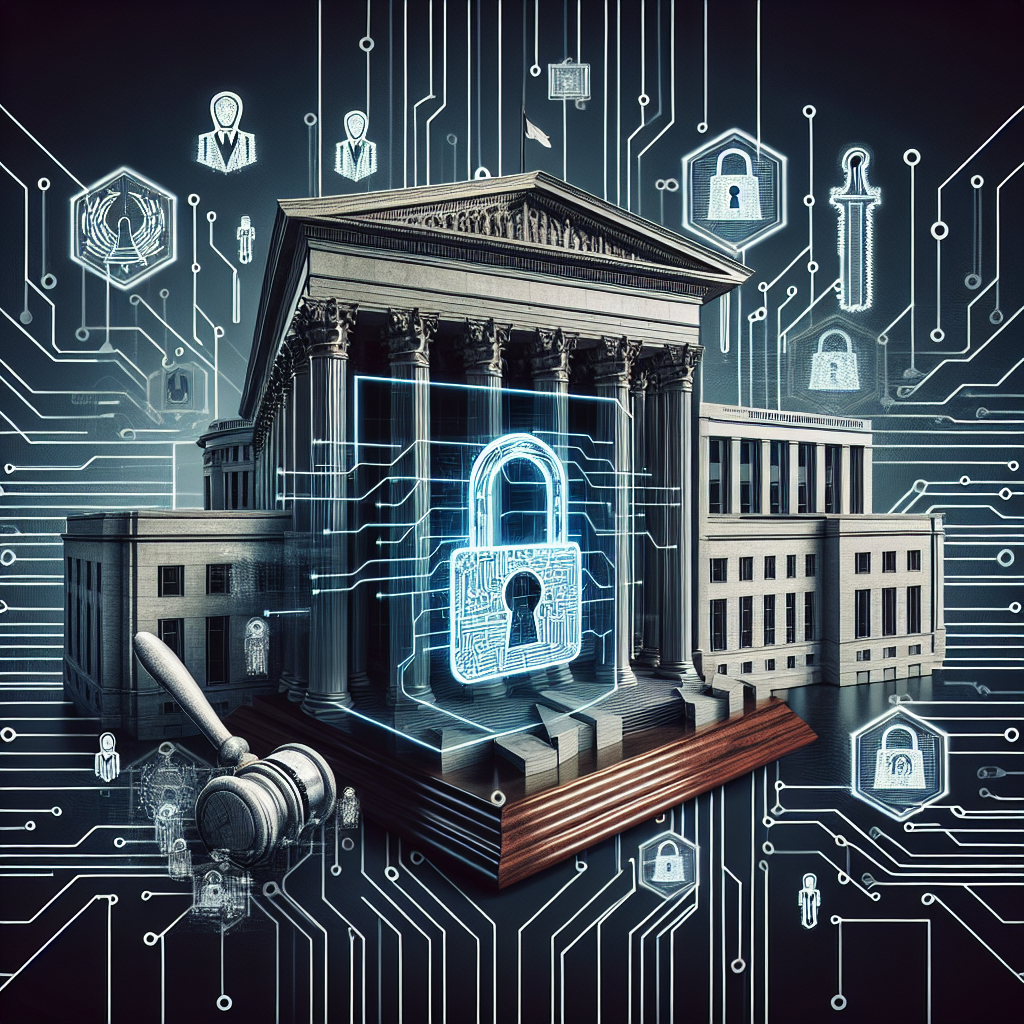Your cart is currently empty!
Tag: Role

The Role of Automation in Improving Network Management Efficiency
In today’s fast-paced digital world, network management has become increasingly complex and demanding. With the exponential growth of data and devices connected to networks, the need for efficient and effective network management has never been more critical. This is where automation plays a crucial role in improving network management efficiency.Automation in network management involves the use of software and tools to perform routine tasks, such as monitoring network performance, troubleshooting issues, and optimizing network resources, without manual intervention. By automating these tasks, network administrators can save time and resources, reduce human errors, and ensure the network runs smoothly and efficiently.
One of the key benefits of automation in network management is its ability to streamline repetitive tasks. For example, instead of manually monitoring network traffic and performance metrics, automation tools can continuously monitor these parameters and alert administrators to any issues or anomalies in real-time. This proactive approach allows network administrators to quickly identify and resolve problems before they impact network performance or user experience.
Automation also plays a significant role in improving network security. By automating security protocols and policies, administrators can ensure that the network is protected from potential threats and vulnerabilities. For example, automation tools can automatically update firewall rules, scan for malware, and enforce access controls, reducing the risk of unauthorized access or data breaches.
Furthermore, automation helps optimize network resources and improve overall performance. By automating tasks such as load balancing, bandwidth management, and resource allocation, administrators can ensure that network resources are utilized efficiently and effectively. This not only improves network performance but also helps reduce operational costs and improve scalability.
In addition, automation enhances network visibility and control. By centralizing network management and monitoring, administrators can gain a comprehensive view of the entire network infrastructure, including devices, applications, and users. This visibility enables administrators to quickly identify trends, analyze performance metrics, and make informed decisions to optimize network performance and reliability.
Overall, automation plays a critical role in improving network management efficiency by streamlining routine tasks, enhancing security, optimizing resource utilization, and providing better visibility and control. As networks continue to grow in complexity and scale, automation will become increasingly essential for organizations to effectively manage their network infrastructure and ensure seamless connectivity for users. By embracing automation in network management, organizations can stay ahead of the curve and meet the evolving demands of the digital age.

The Role of Encryption in Cybersecurity
In today’s digital age, cybersecurity has become a critical issue for individuals, businesses, and governments alike. With the increasing number of cyber threats and attacks, it is more important than ever to protect sensitive information and data from falling into the wrong hands. One of the key tools in the fight against cyber threats is encryption.Encryption is the process of encoding information in such a way that only authorized parties can access it. It involves using algorithms to convert plaintext data into ciphertext, which is essentially scrambled and unreadable without the corresponding decryption key. This ensures that even if a hacker gains access to the encrypted data, they will not be able to decipher it without the key.
The role of encryption in cybersecurity is crucial for several reasons. Firstly, it helps to protect sensitive data from unauthorized access. This includes personal information such as passwords, credit card numbers, and other confidential data that could be used for identity theft or fraud. By encrypting this information, it becomes much more difficult for hackers to intercept and misuse it.
Encryption also plays a vital role in securing communication channels. When data is transmitted over the internet, there is always a risk that it could be intercepted by hackers. By encrypting the data before it is sent, it ensures that even if it is intercepted, it will be unreadable to anyone without the decryption key. This is particularly important for businesses that rely on secure communication channels to conduct their operations.
Furthermore, encryption is essential for protecting intellectual property and trade secrets. Businesses invest a significant amount of time and resources into developing innovative products and services, and it is crucial that this information remains confidential. By encrypting sensitive documents and files, companies can prevent unauthorized access and theft of intellectual property.
In addition to protecting data and communication channels, encryption also helps to ensure compliance with regulatory requirements. Many industries, such as healthcare and finance, are subject to strict data protection regulations that require the use of encryption to safeguard sensitive information. Failure to comply with these regulations can result in hefty fines and damage to the organization’s reputation.
Overall, encryption plays a critical role in cybersecurity by providing a secure means of protecting sensitive information, securing communication channels, safeguarding intellectual property, and ensuring compliance with regulatory requirements. As cyber threats continue to evolve and become more sophisticated, the importance of encryption in protecting against these threats cannot be overstated. Organizations must prioritize the implementation of robust encryption measures to safeguard their data and mitigate the risks posed by cyber attacks.

The Role of IT Consulting in Cybersecurity Risk Management
In today’s digital age, cybersecurity is a top priority for businesses of all sizes. With the increasing number of cyber threats and data breaches, it has become essential for companies to protect their sensitive information and maintain the trust of their customers. This is where IT consulting plays a crucial role in helping organizations manage and mitigate cybersecurity risks.IT consulting firms specialize in providing expert advice and guidance on a wide range of IT-related issues, including cybersecurity. These firms employ highly skilled professionals who have a deep understanding of the latest cyber threats and best practices for protecting against them. By partnering with an IT consulting firm, companies can benefit from their expertise and experience in developing and implementing effective cybersecurity strategies.
One of the key roles of IT consulting in cybersecurity risk management is conducting thorough risk assessments. These assessments involve identifying potential vulnerabilities in a company’s IT infrastructure and determining the likelihood and impact of a cyber attack. By conducting regular risk assessments, IT consulting firms can help businesses stay ahead of emerging threats and proactively address any weaknesses in their security defenses.
In addition to risk assessments, IT consulting firms also play a critical role in helping companies develop and implement cybersecurity policies and procedures. This includes creating incident response plans, establishing access controls, and implementing security awareness training programs for employees. By working closely with IT consultants, organizations can ensure that they have robust cybersecurity measures in place to protect their sensitive data and prevent unauthorized access.
Furthermore, IT consulting firms can also assist companies in selecting and implementing cybersecurity technologies and tools. This includes deploying firewalls, intrusion detection systems, and encryption software to help safeguard their networks and data from cyber threats. By leveraging the expertise of IT consultants, organizations can ensure that they are using the most effective cybersecurity solutions to protect their assets and mitigate risks.
Overall, the role of IT consulting in cybersecurity risk management is invaluable for businesses looking to protect themselves from the growing number of cyber threats. By partnering with an IT consulting firm, companies can benefit from expert advice, guidance, and support in developing and implementing robust cybersecurity strategies. With the help of IT consultants, organizations can strengthen their security defenses, reduce the likelihood of a data breach, and safeguard their reputation in the face of evolving cyber threats.

Understanding the Role of Data Backup and Recovery in Cybersecurity
In today’s digital age, data backup and recovery are crucial components of cybersecurity. With the increasing number of cyber threats and attacks, organizations need to have robust backup and recovery strategies in place to protect their data from being lost or compromised.Data backup refers to the process of creating copies of important files and storing them in a secure location. This ensures that in the event of a cyber attack, natural disaster, or hardware failure, organizations can quickly recover their data and resume normal operations. Data recovery, on the other hand, involves restoring data from backups after it has been lost or corrupted.
One of the key reasons why data backup and recovery are essential in cybersecurity is to protect against ransomware attacks. Ransomware is a type of malware that encrypts a victim’s files and demands payment in exchange for the decryption key. By regularly backing up data and storing it offline, organizations can avoid paying ransom to cybercriminals and restore their files from backups instead.
Moreover, data backup and recovery help organizations comply with data protection regulations and industry standards. Many regulations, such as the General Data Protection Regulation (GDPR) and the Health Insurance Portability and Accountability Act (HIPAA), require organizations to have backup and recovery plans in place to safeguard sensitive information and prevent data breaches.
In addition, data backup and recovery can also improve business continuity and reduce downtime. By having multiple copies of data stored in different locations, organizations can quickly recover from disruptions and minimize the impact of cyber attacks or disasters on their operations. This ensures that critical systems and services remain available to employees and customers.
To effectively implement data backup and recovery in cybersecurity, organizations should follow best practices such as:
1. Regularly backing up data: Organizations should schedule automated backups of critical files and databases on a regular basis to ensure that no data is lost in the event of an incident.
2. Storing backups securely: Backup data should be encrypted and stored in secure locations, such as offsite or in the cloud, to prevent unauthorized access and ensure data confidentiality.
3. Testing backups: Organizations should regularly test their backup and recovery processes to ensure that data can be successfully restored in case of an emergency.
4. Updating backup strategies: Organizations should review and update their backup and recovery strategies periodically to adapt to changing cybersecurity threats and business needs.
In conclusion, data backup and recovery play a crucial role in cybersecurity by protecting against ransomware attacks, ensuring compliance with regulations, improving business continuity, and reducing downtime. By implementing robust backup and recovery strategies, organizations can safeguard their data and operations against cyber threats and disasters.

The Role of Government in Cybersecurity: Policies and Regulations
In today’s digital age, cybersecurity has become a top priority for governments around the world. With cyber threats becoming increasingly sophisticated and widespread, it is crucial for governments to play a central role in safeguarding their citizens, businesses, and critical infrastructure from cyber attacks.The role of government in cybersecurity encompasses a wide range of activities, including the development and implementation of policies and regulations to protect against cyber threats. Governments are responsible for setting the regulatory framework for cybersecurity, which includes establishing guidelines for securing critical infrastructure, protecting sensitive data, and responding to cyber incidents.
One of the key responsibilities of government in cybersecurity is to create and enforce laws and regulations that mandate cybersecurity measures for organizations and individuals. This can involve requirements for organizations to implement specific cybersecurity controls, such as encryption, access controls, and regular security assessments. Governments also have the authority to impose penalties on organizations that fail to comply with cybersecurity regulations, in order to incentivize adherence to best practices.
In addition to setting regulations, governments play a crucial role in coordinating cybersecurity efforts across different sectors and industries. This includes fostering collaboration between government agencies, private sector organizations, and international partners to share information about cyber threats and best practices for mitigating them. Governments may also establish cybersecurity information sharing platforms, such as Computer Emergency Response Teams (CERTs), to facilitate the exchange of threat intelligence and incident response coordination.
Furthermore, governments have a responsibility to educate and raise awareness about cybersecurity risks among citizens and businesses. This can involve providing resources and guidance on how to secure personal devices, protect sensitive information, and recognize common cyber threats, such as phishing scams and malware attacks. By promoting cybersecurity awareness, governments can help empower individuals and organizations to take proactive measures to protect themselves from cyber threats.
Overall, the role of government in cybersecurity is essential for ensuring the security and resilience of digital systems and infrastructure. By developing and enforcing policies and regulations, coordinating cybersecurity efforts, and promoting awareness, governments can help mitigate cyber risks and protect their citizens from the growing threat of cyber attacks. As technology continues to evolve and cyber threats become more sophisticated, the role of government in cybersecurity will only become more critical in safeguarding our digital future.

The Role of MSPs in Digital Transformation for Businesses
In today’s rapidly evolving digital landscape, businesses are constantly looking for ways to stay ahead of the curve and remain competitive. One key strategy that many businesses are turning to is digital transformation. This process involves using technology to fundamentally change the way a business operates and delivers value to its customers.While digital transformation can bring about numerous benefits, such as increased efficiency, improved customer experience, and enhanced innovation, it can also be a complex and challenging process. This is where Managed Service Providers (MSPs) come in.
MSPs play a crucial role in helping businesses navigate the digital transformation journey. They provide a range of services, including cloud computing, cybersecurity, data management, and IT support, that are essential for implementing and maintaining the digital tools and infrastructure needed for a successful transformation.
One of the key benefits of working with an MSP is their expertise and experience in implementing digital solutions. MSPs have a deep understanding of the latest technologies and best practices, which allows them to help businesses select and deploy the right tools for their specific needs. This expertise can help businesses avoid costly mistakes and ensure a smooth transition to a digital-first mindset.
Additionally, MSPs can help businesses overcome common challenges that arise during digital transformation, such as security threats, data breaches, and system downtime. By providing proactive monitoring and support services, MSPs can help businesses identify and address potential issues before they become major problems, ensuring that their digital transformation remains on track.
Furthermore, MSPs can also help businesses manage the complexity of modern IT environments. As businesses increasingly rely on a mix of on-premises, cloud-based, and hybrid IT solutions, the need for comprehensive management and support services becomes more important. MSPs can help businesses streamline their IT operations, improve efficiency, and reduce costs by providing a single point of contact for all their IT needs.
In conclusion, MSPs play a vital role in supporting businesses on their digital transformation journey. By leveraging their expertise, experience, and resources, MSPs can help businesses implement and maintain the digital tools and infrastructure needed to drive innovation, improve efficiency, and enhance customer experience. As businesses continue to embrace digital transformation as a strategic priority, partnering with an MSP can be a valuable investment that can help ensure long-term success in the digital age.

Building Resilience: The Role of Disaster Recovery in Business Continuity
In today’s fast-paced and unpredictable business environment, the ability to bounce back from setbacks and disasters is more important than ever. Building resilience is crucial for companies to stay competitive and thrive in the face of unexpected challenges. Disaster recovery plays a key role in ensuring business continuity and helping organizations recover quickly from disruptions.Disasters can come in many forms, from natural disasters like hurricanes and earthquakes to man-made incidents such as cyber-attacks and industrial accidents. These events can have a devastating impact on businesses, causing downtime, loss of revenue, and damage to reputation. Without a solid disaster recovery plan in place, companies risk losing customers, market share, and even going out of business.
Disaster recovery is the process of planning for and responding to disasters in order to minimize their impact on an organization. It involves identifying potential risks, developing strategies to mitigate those risks, and implementing measures to ensure business continuity in the event of a disaster. This includes backing up data, establishing emergency communication protocols, and developing contingency plans for key business processes.
One of the key benefits of disaster recovery is that it helps organizations recover quickly from disruptions, minimizing downtime and reducing the financial impact of disasters. By having a plan in place, companies can resume operations as soon as possible and minimize the impact on employees, customers, and stakeholders. This can help businesses maintain their competitive edge and protect their bottom line in the face of unexpected challenges.
In addition to minimizing the impact of disasters, disaster recovery also helps organizations build resilience and adaptability. By going through the process of creating a disaster recovery plan, companies can identify vulnerabilities in their operations and develop strategies to address them. This can help organizations become more agile and responsive to changing circumstances, enabling them to thrive in the face of uncertainty.
Building resilience through disaster recovery is not just about protecting against catastrophic events – it’s also about being prepared for everyday challenges and disruptions. By having a solid disaster recovery plan in place, companies can better respond to unexpected events such as power outages, equipment failures, and data breaches. This can help organizations maintain business continuity and minimize the impact of disruptions on their operations.
Overall, building resilience through disaster recovery is an essential component of business continuity planning. By identifying potential risks, developing strategies to mitigate those risks, and implementing measures to ensure business continuity, organizations can protect themselves against unexpected challenges and recover quickly from disruptions. In today’s unpredictable business environment, building resilience is a key factor in staying competitive and thriving in the face of adversity.

The Role of Remote Monitoring in Disaster Preparedness and Recovery
Disasters, whether natural or man-made, can strike at any time and place, leaving behind a trail of destruction and chaos. In such situations, timely and effective response is crucial to minimize the impact on lives and property. Remote monitoring technology plays a critical role in disaster preparedness and recovery efforts by providing real-time data and insights to help first responders and relief agencies make informed decisions.One of the key advantages of remote monitoring technology is its ability to provide early warning of impending disasters. For example, sensors placed in areas prone to earthquakes, floods, or wildfires can detect changes in environmental conditions and alert authorities to potential risks before they escalate. This early warning system allows for the timely evacuation of at-risk populations and the mobilization of resources to mitigate the impact of the disaster.
During a disaster, remote monitoring technology can also play a vital role in assessing the extent of damage and monitoring the progress of recovery efforts. Drones equipped with cameras and sensors can be deployed to survey affected areas and provide high-resolution images and data to aid in damage assessment and decision-making. This information can help authorities prioritize response efforts, allocate resources efficiently, and monitor the effectiveness of recovery activities.
Furthermore, remote monitoring technology can enhance communication and coordination among different agencies and organizations involved in disaster response and recovery. Real-time data sharing and collaboration platforms enable stakeholders to exchange information, coordinate efforts, and make decisions based on a common operating picture. This seamless communication and coordination are essential for ensuring a swift and effective response to disasters.
In addition, remote monitoring technology can also help in monitoring the safety and well-being of affected populations during and after a disaster. Wearable devices and smart sensors can track vital signs, location, and other relevant data to ensure the timely delivery of medical assistance and support services to those in need. This real-time monitoring capability can help save lives and reduce the severity of injuries in the aftermath of a disaster.
Overall, remote monitoring technology plays a crucial role in disaster preparedness and recovery efforts by providing early warning, assessing damage, enhancing communication and coordination, and monitoring the safety of affected populations. By leveraging the power of technology, first responders and relief agencies can better prepare for disasters, respond more effectively to emergencies, and facilitate the recovery process to restore normalcy and resilience in affected communities.

The Role of SLAs in Customer Satisfaction and Retention
Service Level Agreements (SLAs) play a crucial role in ensuring customer satisfaction and retention for businesses. An SLA is a contract that defines the level of service a customer can expect from a service provider, including metrics for performance and expectations for response times. By setting clear expectations and holding service providers accountable for meeting them, SLAs can help businesses build trust with their customers and ultimately improve customer satisfaction and retention.One of the key ways that SLAs contribute to customer satisfaction is by providing transparency and clarity in the service relationship. When customers know exactly what level of service to expect, they are more likely to be satisfied with the service they receive. This transparency also helps build trust between the customer and the service provider, as the customer can feel confident that the provider will deliver on their promises.
In addition to setting clear expectations, SLAs also help businesses measure and track their performance against those expectations. By defining specific metrics for performance, such as uptime, response times, and resolution times, businesses can monitor their performance and identify areas for improvement. This allows businesses to proactively address any issues that may arise and continuously improve their service delivery, ultimately leading to higher levels of customer satisfaction.
Furthermore, SLAs can also help businesses prioritize their resources and focus on the most critical aspects of their service delivery. By setting specific targets for performance, businesses can allocate resources effectively and ensure that they are meeting the needs of their customers. This focus on delivering high-quality service can help businesses differentiate themselves from their competitors and retain customers in a highly competitive market.
Ultimately, by setting clear expectations, measuring performance, and prioritizing resources, SLAs can play a crucial role in improving customer satisfaction and retention. Businesses that prioritize customer satisfaction and invest in strong SLAs are more likely to build long-term relationships with their customers and achieve sustainable growth in the market. As such, businesses should consider implementing SLAs as a key tool in their customer service strategy to drive customer satisfaction and retention.

The Role of IT Infrastructure Management in Ensuring Security and Compliance
In today’s digital age, businesses rely heavily on their IT infrastructure to operate efficiently and effectively. This infrastructure includes hardware, software, networks, and data storage systems that enable organizations to communicate, collaborate, and conduct business online. However, with this reliance on technology comes the need for effective IT infrastructure management to ensure security and compliance.IT infrastructure management is the practice of managing and maintaining the components of an organization’s IT infrastructure to ensure that they are secure, efficient, and compliant with regulatory requirements. This includes monitoring and managing hardware and software assets, configuring and maintaining networks, and implementing security measures to protect sensitive data.
One of the key roles of IT infrastructure management is to ensure the security of an organization’s IT systems. This involves implementing security measures such as firewalls, antivirus software, and encryption to protect against cyber threats such as malware, phishing attacks, and data breaches. IT infrastructure management also involves regularly updating software and patching vulnerabilities to prevent security breaches.
In addition to security, IT infrastructure management plays a crucial role in ensuring compliance with regulatory requirements and industry standards. Many industries, such as healthcare and finance, have strict regulations governing the storage and transmission of sensitive data. IT infrastructure management helps organizations comply with these regulations by implementing security controls, conducting regular audits, and maintaining detailed records of IT activities.
Effective IT infrastructure management also helps organizations reduce the risk of downtime and data loss. By monitoring and maintaining hardware and software assets, IT teams can identify and address potential issues before they lead to system failures. This proactive approach to IT infrastructure management helps organizations minimize disruptions to business operations and protect critical data.
Overall, IT infrastructure management is essential for ensuring the security and compliance of an organization’s IT systems. By implementing security measures, monitoring for vulnerabilities, and maintaining regulatory compliance, IT teams can help protect sensitive data, reduce the risk of downtime, and ensure that the organization can continue to operate smoothly in today’s digital world.
